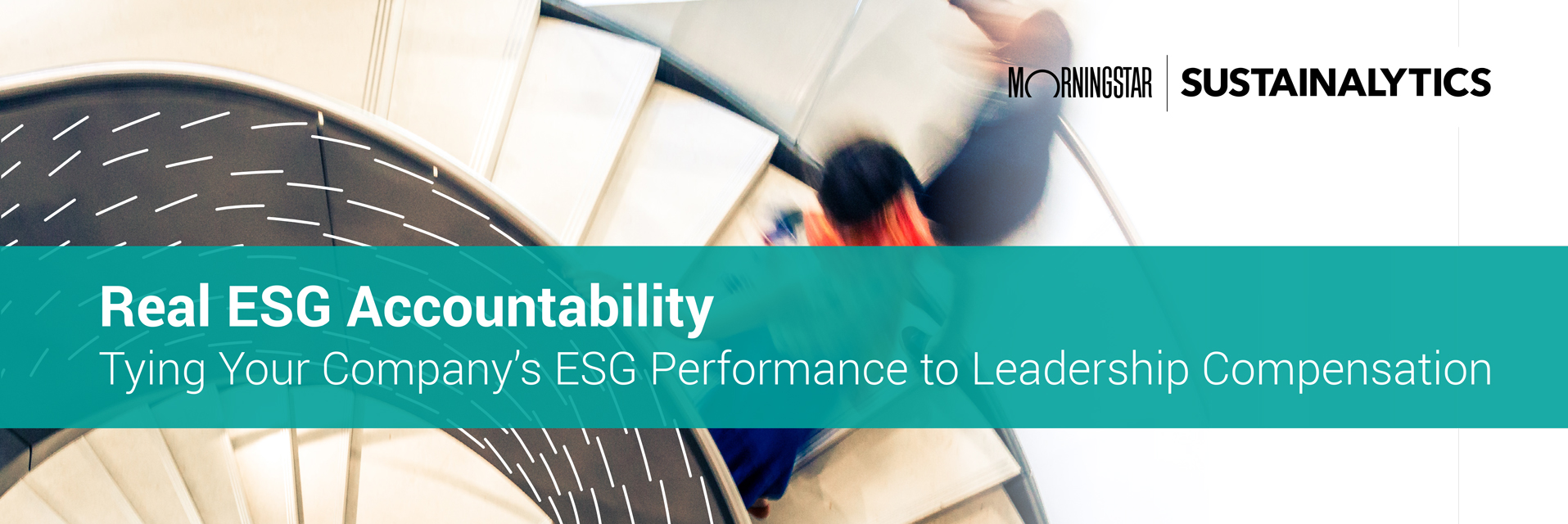Environmental, social, and governance (ESG) issues are increasingly making their way to corporate boardrooms, as topics of discussions tying into company strategy. One of these issues is leadership compensation, and whether it makes sense for incentives to be tied to ESG-related goals. In this blog post, we look at why more companies are adopting this practice, and why they have good reasons for doing so.
The Rise of Transparent Executive ESG Pay-Links
Public companies have begun to incorporate ESG performance metrics into their executives' compensation packages as part of efforts to widen their accountability beyond shareholders. In the United Kingdom, for example, in 2020, 31% of FTSE 100 companies included ESG measures in executives’ annual bonus requirements; in 2021, the number had grown to 51%.i There are multiple reasons for this.
Sustainalytics’ data indicates that approximately 17% of European public companies have implemented an ESG pay-link.ii In the United States and Canada, more than 13% of public firms have an ESG pay-link.iii In the less prescriptive North American environment, companies do not have the same motivation to implement ESG incentive plans as in Europe, although leading companies continue to move in this direction.
Less than 4% of Asia-Pacific companies currently have an ESG incentive plan in place.iv However, almost 70% of firms in the region plan to introduce ESG measures into their long-term incentive plans over the next three years, while 61% plan to do the same with their short-term plans.v
Research shows that others will follow as standards evolve and regulation advances. One 2021 survey of 100 top U.S. companies found 45% already using ESG pay-links, with another 15% planning to do so.vi
Source: Sustainalytics | For Informational Purposes Only
Corporate Goals Can Be Supported With ESG Metrics
It appears that more and more companies are recognizing the potential value that linking executive compensation to ESG metrics can provide. Here are five compelling reasons companies are adopting this practice.
Reason One: Stakeholder Pressure Matters
Corporate policies that link ESG targets to executive performance have become a clear priority for investors. Other stakeholders are paying attention too. Regulators, NGOs, employees, customers, are all scrutinizing companies’ practices for remuneration-related proposals and their impact on business goals.
Reason Two: Executive Action Can Be Aligned to Corporate Strategy
Linking pay to ESG performance can align executive action with corporate strategy in a couple of important ways. First, by going through the process of choosing material ESG issues (MEIs) and setting credible targets, companies and their boards and executives can gain insight into how to effectively meet strategic priorities. Then, the ESG-based incentive can focus executives' attention on non-financial topics that are important to corporate strategy.
Reason Three: Accountability Makes a Difference
With increased scrutiny on corporate ESG risk, tying variable compensation to ESG performance provides an additional tool for firms and boards to hold their executives to account. It also communicates their principles and objectives to employees, investors, regulators, and other stakeholders. This is especially important when it comes to companies in high ESG risk industries. They may have a wider range of difficult MEIs to address, which require immense focus from senior leadership.
Reason Four: Financial Performance Can Improve
An effective ESG pay-link may enhance financial performance in a number of ways. In terms of enterprise value, there’s mounting evidence that ESG-integrated portfolios provide better financial returns than benchmarks, plus improved risk management. Another way companies can potentially improve financial performance is through improved corporate decision making due to more and better quality strategic data. One 2020 survey found that 43% of investors believe applying ESG criteria to corporate decision-making leads to enhanced financial results, an increase of 14% over 2019.vii ESG management practices may also improve a company’s bottom line by cutting waste and using resources more efficiently, bolstering brand value and goodwill, reducing turnover and associated costs, attracting talent, minimizing penalties and fees, accessing capital required for growth, and tapping into new business opportunities and strategies that are linked to ESG initiatives.
Reason Five: Championing Social Issues
Large firms are using sustainability-linked compensation to address social concerns, such as improving racial, disability and gender diversity, equity, and inclusion, employee engagement, and other issues that get in the way of creating inclusive and ethical workplaces. Fortune 500 companies like Starbucks, McDonald’s, and Nike have pledged to use workforce inclusion KPIs as a metric to calculate executive compensation.viii Diversity has also been shown to enhance profitability for organizations.
Unlocking Strategic Value
Interest in linking compensation to ESG performance has expanded beyond trendsetting multinationals. This is not just in response to investor and stakeholder pressure, but a function of increased awareness of ESG issues and how they impact strategic priorities, combined with the prospect of regulation.
For decades, companies have structured their compensation packages to ensure that the incentives provided to individual executives align with broad corporate financial and operational goals. Now that companies are integrating material ESG issues into their strategies, it is the logical next step to incentivize executives to improve performance on these issues in a measurable way.
It may take time for ESG pay-links to become a truly effective way to advance a firm’s strategic sustainability progress. But those that manage to do it well can end up meeting stakeholder needs, aligning executive action to corporate strategy, offering more accountability, improving financial performance, and championing social issues. They can also build trust with investors, employees, and other stakeholders, enhance their transparency, and find themselves better prepared for disclosure regulations.
Read our latest ebook for a more in-depth look at why companies are beginning to tie leadership compensation to ESG metrics.

Sources
i Verney, P., and Gambetta, G. (2021). "Companies embrace ESG metrics in pay packages," Responsible Investor, accessed (06.03.2022) at: https://www.responsible-investor.com/companies-embrace-esg-metrics-in-pay-packages/
ii This and all subsequent references to Sustainalytics’ data, risk ratings, etc., refer to Sustainalytics’ proprietary methodology and research universe.
iii Sustainalytics’ proprietary data.
iv Sustainalytics’ proprietary data.
v Ashwell, B., Human, T., and Roach, G. (2021). “Put your money where your values are,” IR Magazine, Issue 286, accessed (13.05.2022) at: https://content.irmagazine.com/story/ir-magazine-spring-2021/page/10/9
vi Norton, L. (2021): "Here's One Way Shareholders Can Get Companies to Act on Global Warming," Morningstar, accessed (06.03.2022) at: https://www.morningstar.com/articles/1070817/heres-one-way-shareholders-can-getcompanies-to-act-on-global-warming
vii Behrens, M. and Anderson, A., Shearman & Sterling LLP (2021). "ESG Continues to Find its Way into Incentive Compensation Plans", Harvard Law School Forum on Corporate Governance, accessed (06.03.2022) at: https://corpgov.law.harvard.edu/2021/12/02/esg-continues-to-find-its-way-into-incentive-compensation-plans/
viii Vezér, M., and Wennerström, M. (2020). "ESG Spotlight | The State of Pay: Executive Remuneration & ESG Metrics," Sustainalytics, accessed (06.03.2022) at: https://connect.sustainalytics.com/esg-spotlight-the-state-of-pay
Recent Content
Risk and Opportunity in Biodiversity: How Sustainable Finance Can Help
This article outlines how biodiversity loss poses material risks to business and how it connects to many other issues that companies can’t ignore. In addition, it covers how biodiversity conservation presents substantial economic opportunities, and how businesses can address and access these opportunities by issuing linked instruments that integrate biodiversity considerations.
Today’s Sustainable Bond Market: Boosting Confidence in Sustainable Bond Issuances
In this article, we examine the kinds of sustainable bonds offered in the market, some of the key regulations being developed in different markets and the current initiatives to improve the quality and credibility of issuances.
Webinar Recap: How Integrating ESG Can Drive Opportunity for Private Companies
Recently, Morningstar Sustainalytics hosted a webinar – ESG in the Lifecycle of a Private Company: How Stakeholder Demands Drive Sustainability in Private Markets – to address some of the questions private companies might have surrounding ESG and how it could impact their business.




